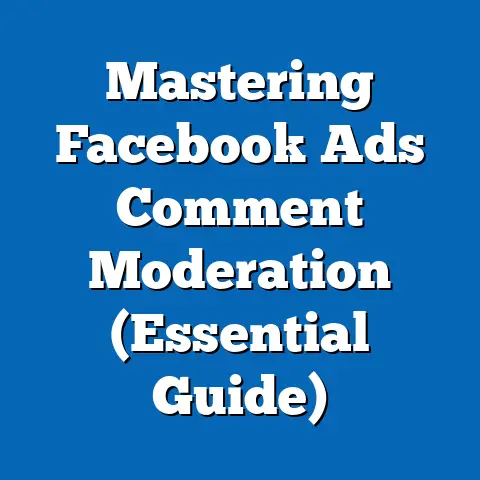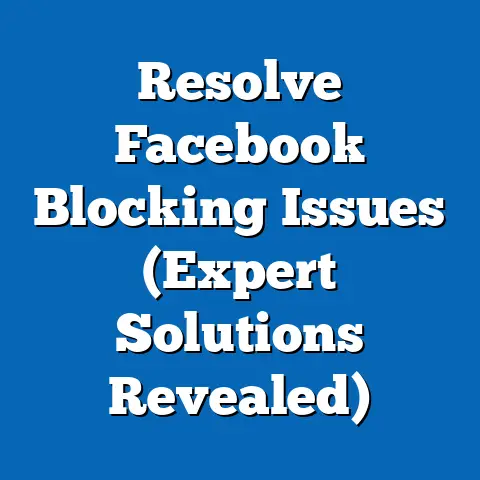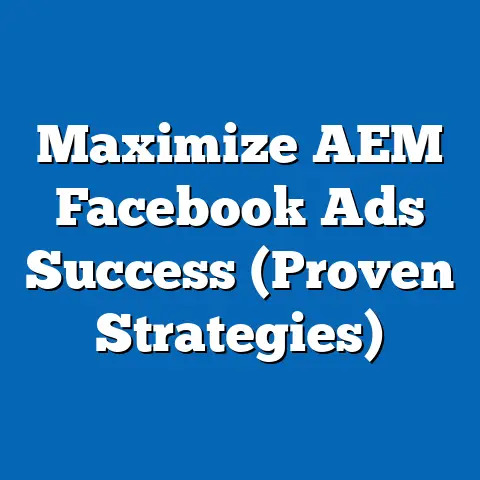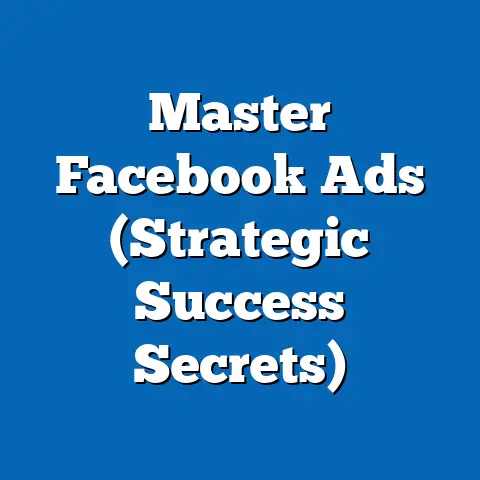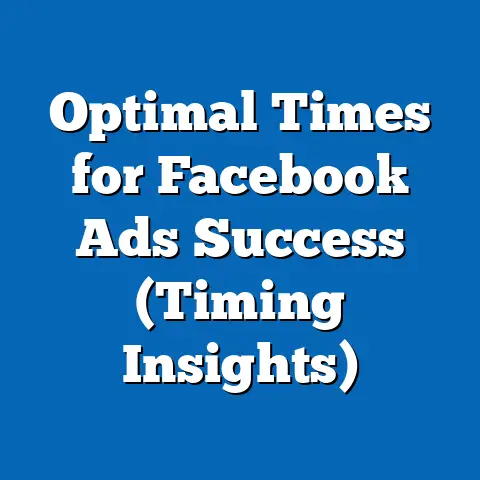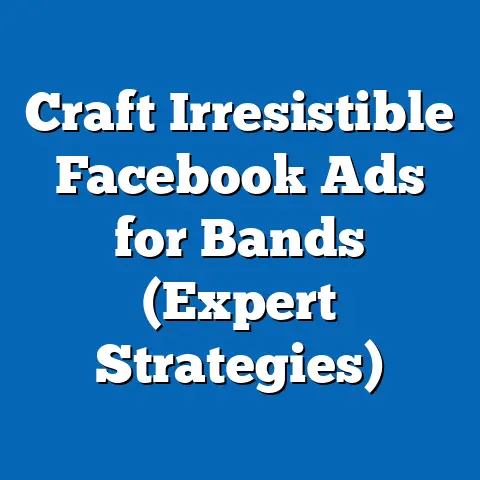Master Auto Facebook Ads (Proven Strategies for Results)
Facebook advertising has become an indispensable tool for businesses across various sectors, and the automotive industry is no exception. In this digital age, where consumers spend a significant amount of time online, Facebook offers an unparalleled platform to reach potential car buyers, service seekers, and auto parts enthusiasts. But simply running ads isn’t enough; mastering auto Facebook ads requires a strategic approach to cut through the noise and connect with your target audience effectively.
I’ve seen firsthand how a well-crafted Facebook ad campaign can transform a struggling dealership into a local powerhouse. Years ago, I worked with a small-town dealership that was barely making ends meet. Their traditional advertising methods were failing, and they were hesitant to embrace digital marketing. After convincing them to invest in a targeted Facebook ad campaign, we saw a remarkable turnaround. By understanding their audience, creating compelling content, and continuously optimizing our strategy, we boosted their sales by 40% in just six months.
Section 1: Understanding the Facebook Advertising Landscape
Facebook’s advertising platform is a behemoth, boasting billions of active users worldwide. This vast reach makes it an attractive option for businesses looking to connect with potential customers. But what makes Facebook ads particularly effective for the automotive industry?
First, consider the sheer volume of potential customers. Facebook’s detailed targeting capabilities allow you to reach users based on demographics, interests, behaviors, and more. This means you can target individuals actively researching cars, those who have recently visited automotive websites, or even those who have expressed interest in specific vehicle brands.
For automotive businesses, Facebook ads offer several key advantages:
- Targeted Reach: Reach potential customers based on their interests, behaviors, demographics, and more.
- Cost-Effectiveness: Compared to traditional advertising methods, Facebook ads can be more budget-friendly and offer better ROI.
- Measurable Results: Track key metrics such as impressions, CTR, conversion rates, and ROAS to gauge the effectiveness of your campaigns.
- Brand Awareness: Increase brand visibility and recognition among your target audience.
- Lead Generation: Generate leads through lead ads, which allow users to submit their information directly from the ad.
To succeed with Facebook ads, it’s crucial to understand the key metrics that indicate success. Here are some of the most important:
- Impressions: The number of times your ad is displayed to users.
- Click-Through Rate (CTR): The percentage of users who click on your ad after seeing it.
- Conversion Rate: The percentage of users who complete a desired action, such as filling out a form or making a purchase, after clicking on your ad.
- Cost Per Click (CPC): The amount you pay each time a user clicks on your ad.
- Cost Per Lead (CPL): The amount you pay for each lead generated through your ad.
- Return on Ad Spend (ROAS): The revenue generated for every dollar spent on advertising.
Understanding these metrics allows you to assess the performance of your ads and make data-driven decisions to optimize your campaigns.
Audience segmentation and targeting are critical for maximizing ad effectiveness. By dividing your audience into smaller, more specific segments, you can tailor your ads to resonate with each group’s unique needs and interests. For example, you might create separate audience segments for first-time car buyers, luxury vehicle enthusiasts, and truck owners.
Takeaway: The Facebook advertising landscape offers immense potential for automotive businesses. By understanding the platform’s reach, targeting capabilities, and key metrics, you can create effective campaigns that drive results.
Section 2: Crafting Compelling Ad Content
The content of your Facebook ads is what ultimately captures attention and drives action. In the automotive industry, where competition is fierce, crafting compelling ad content is essential for standing out from the crowd.
High-performing ad copy should be:
- Clear and Concise: Get straight to the point and highlight the key benefits of your offer.
- Benefit-Oriented: Focus on how your product or service solves a problem or fulfills a need for the customer.
- Emotionally Engaging: Tap into the emotions that drive car-buying decisions, such as excitement, security, and status.
- Urgent: Create a sense of urgency to encourage immediate action.
- Specific: Provide specific details about your offer, such as pricing, features, and availability.
Here’s an example of effective ad copy for a dealership:
“Drive home in your dream car today! 🚗 Get 0% financing on all new SUVs this month only. Visit our showroom or browse our inventory online now!”
Visuals play a crucial role in Facebook ads. High-quality images and videos of vehicles can capture attention and showcase the features and benefits of your products.
- Use Professional Photography: Invest in high-quality photos that showcase your vehicles in the best light.
- Create Engaging Videos: Videos can be used to highlight vehicle features, showcase customer testimonials, or provide virtual tours of your showroom.
- Optimize Visuals for Mobile: Ensure your visuals are optimized for mobile devices, as most Facebook users access the platform on their phones.
Headlines are the first thing users see, so they need to be attention-grabbing and compelling. Here are some tips for writing effective headlines:
- Use Numbers: Numbers can make your headlines more specific and attention-grabbing (e.g., “5 Reasons to Buy a New Truck”).
- Ask a Question: Questions can pique curiosity and encourage users to click on your ad (e.g., “Ready for Your Next Adventure?”).
- Highlight a Benefit: Focus on the key benefit of your offer (e.g., “Save Thousands on Your Next Car”).
- Create Urgency: Use words like “Limited Time” or “Today Only” to create a sense of urgency.
Storytelling is a powerful technique for connecting with potential car buyers on an emotional level. By sharing stories about how your vehicles have helped customers achieve their goals or overcome challenges, you can create a deeper connection and build trust.
For instance, I once crafted an ad campaign for a local dealership that focused on customer stories. We featured a family who had outgrown their sedan and needed a minivan for their growing family. The ad showcased how the dealership helped them find the perfect vehicle to meet their needs, highlighting the spaciousness, safety features, and family-friendly amenities of the minivan. This campaign resonated with other families in the area and led to a significant increase in minivan sales.
Takeaway: Compelling ad content is essential for capturing attention and driving action. By crafting clear and concise ad copy, using high-quality visuals, writing attention-grabbing headlines, and incorporating storytelling techniques, you can create Facebook ads that resonate with your target audience and deliver results.
Section 3: Targeting the Right Audience
Audience targeting is the cornerstone of effective Facebook advertising. Without the right targeting, even the most compelling ad content will fall flat. Facebook offers a wide range of targeting options, allowing you to reach specific groups of people based on their demographics, interests, behaviors, and more.
Demographic targeting allows you to reach users based on factors such as age, gender, location, education, and income. This can be particularly useful for targeting specific segments of the automotive market. For example, you might target young professionals with ads for sporty sedans or affluent families with ads for luxury SUVs.
Interest targeting allows you to reach users based on their interests and hobbies. This can be a great way to target potential car buyers who are interested in specific vehicle brands, types of vehicles, or automotive-related topics. For example, you might target users interested in “trucks,” “SUVs,” or “electric vehicles.”
Behavior targeting allows you to reach users based on their online behavior, such as their purchase history, website visits, and app usage. This can be a powerful way to target potential car buyers who are actively researching vehicles or have recently visited automotive websites. For example, you might target users who have visited websites like Edmunds or Kelley Blue Book.
Custom audiences allow you to upload your own customer data, such as email addresses or phone numbers, and target those users on Facebook. This can be a great way to reach existing customers or leads who have already expressed interest in your business.
Lookalike audiences allow you to reach potential customers who are similar to your existing customers. Facebook analyzes the characteristics of your existing customers and finds other users who share similar traits. This can be a powerful way to expand your reach and find new customers who are likely to be interested in your products or services.
Creating audience personas is a valuable exercise for understanding your target audience and tailoring your ads to their specific needs and interests. An audience persona is a fictional representation of your ideal customer, based on research and data about your existing customers.
Here’s an example of an audience persona for a luxury SUV:
- Name: Sarah
- Age: 45
- Occupation: Executive
- Income: \$200,000+
- Interests: Luxury travel, fine dining, designer fashion
- Values: Status, comfort, safety
By creating audience personas, you can gain a deeper understanding of your target audience and create ads that resonate with their unique needs and desires.
Takeaway: Targeting the right audience is crucial for maximizing ad performance. By leveraging Facebook’s various targeting options and creating audience personas, you can reach the right people with the right message and drive results.
Section 4: Utilizing Facebook Ad Formats
Facebook offers a variety of ad formats, each with its own strengths and weaknesses. Understanding the different formats and when to use them is essential for creating effective campaigns.
Image ads are the simplest and most common type of Facebook ad. They consist of a single image, ad copy, and a call-to-action button. Image ads are great for showcasing a specific vehicle, highlighting a special offer, or promoting brand awareness.
Video ads are more engaging than image ads and can be used to tell a story, showcase vehicle features, or provide customer testimonials. Video ads are particularly effective for capturing attention and driving engagement.
Carousel ads allow you to showcase multiple images or videos in a single ad. This format is great for highlighting different features of a vehicle, showcasing multiple vehicles, or telling a story across multiple cards.
Lead ads are designed to generate leads by allowing users to submit their information directly from the ad. This format is great for collecting email addresses, phone numbers, or other information from potential customers who are interested in learning more about your products or services.
Here’s an example of how each ad format can be used effectively in the automotive industry:
- Image Ad: Showcase a new model with a special financing offer.
- Video Ad: Highlight the safety features of a family SUV.
- Carousel Ad: Showcase different angles and features of a sports car.
- Lead Ad: Collect contact information from users interested in scheduling a test drive.
A/B testing different ad formats is essential for identifying what works best for your audience. By creating multiple versions of your ad with different formats, you can track which format performs best in terms of impressions, CTR, conversion rates, and other key metrics.
I remember one instance where a dealership was struggling to generate leads for their service department. They were running image ads with a generic message about oil changes. After A/B testing lead ads with a special offer for first-time customers, they saw a significant increase in lead generation. The lead ads allowed users to easily submit their contact information and schedule an appointment, making the process much more convenient.
Takeaway: Facebook offers a variety of ad formats, each with its own strengths and weaknesses. By understanding the different formats and A/B testing them to identify what works best for your audience, you can create effective campaigns that drive results.
Section 5: Budgeting and Bidding Strategies
Budgeting and bidding strategies play a crucial role in determining the success of your Facebook ad campaigns. Setting the right budget and choosing the right bidding strategy can help you maximize your ROI and achieve your advertising goals.
Facebook offers two main budgeting options:
- Daily Budget: The average amount you’re willing to spend each day on your ad campaign.
- Lifetime Budget: The total amount you’re willing to spend on your ad campaign over its entire duration.
The best budgeting option for you will depend on your specific goals and needs. If you’re running a short-term campaign with a specific end date, a lifetime budget may be the best option. If you’re running an ongoing campaign, a daily budget may be more appropriate.
Facebook offers two main bidding strategies:
- Automatic Bidding: Facebook automatically sets your bids to get the most results for your budget.
- Manual Bidding: You manually set your bids for each ad set.
Automatic bidding is a good option for beginners, as it takes the guesswork out of bidding. However, manual bidding can give you more control over your ad spend and allow you to optimize your bids based on performance metrics.
Monitoring ad spend is essential for ensuring that you’re staying within your budget and achieving your desired results. Facebook Ads Manager provides detailed reports on your ad spend, allowing you to track your progress and make adjustments as needed.
Maximizing ROI while minimizing costs is the ultimate goal of any advertising campaign. Here are some tips for achieving this in the automotive advertising space:
- Target the Right Audience: Make sure you’re targeting the right people with the right message.
- Create Compelling Ad Content: Use high-quality visuals, attention-grabbing headlines, and clear and concise ad copy.
- A/B Test Your Ads: Continuously test different versions of your ads to identify what works best.
- Monitor Your Ad Spend: Keep a close eye on your ad spend and make adjustments as needed.
- Optimize Your Bids: Use manual bidding to optimize your bids based on performance metrics.
Takeaway: Budgeting and bidding strategies are crucial for maximizing ROI. By setting the right budget, choosing the right bidding strategy, monitoring your ad spend, and optimizing your bids, you can achieve your advertising goals while minimizing costs.
Section 6: Analyzing Ad Performance and Making Adjustments
Analyzing ad performance and making data-driven adjustments is essential for achieving long-term success with Facebook ads. Without a clear understanding of your ad performance, you won’t be able to identify what’s working and what’s not, and you’ll be wasting your time and money.
Facebook Ads Manager is the primary tool for analyzing your ad performance. It provides detailed reports on key metrics such as impressions, CTR, conversion rates, CPC, CPL, and ROAS. You can also use third-party analytics tools to get a more comprehensive view of your ad performance.
Interpreting KPIs is crucial for understanding the effectiveness of your ads. Here’s what each KPI reveals:
- Impressions: Indicates how many people are seeing your ads.
- CTR: Indicates how engaging your ads are.
- Conversion Rate: Indicates how effective your ads are at driving desired actions.
- CPC: Indicates how efficiently you’re spending your budget.
- CPL: Indicates how effectively you’re generating leads.
- ROAS: Indicates how much revenue you’re generating for every dollar spent on advertising.
Based on these insights, you can make data-driven adjustments to your campaigns. Here’s a step-by-step guide:
- Identify Underperforming Ads: Look for ads with low CTR, low conversion rates, or high CPC/CPL.
- Analyze the Data: Determine why these ads are underperforming. Are they targeting the wrong audience? Is the ad content not compelling?
- Make Adjustments: Based on your analysis, make adjustments to your targeting, ad content, or bidding strategy.
- Monitor the Results: Track the performance of your adjusted ads to see if they’re improving.
- Repeat: Continuously analyze your ad performance and make adjustments as needed.
Continuous testing and optimization are essential for achieving long-term success with Facebook ads. The Facebook advertising landscape is constantly evolving, so it’s important to stay up-to-date on the latest trends and best practices.
I’ve learned that the key to successful Facebook advertising is to never stop learning and experimenting. What worked yesterday may not work tomorrow, so it’s important to stay agile and adapt your strategies as needed.
Takeaway: Analyzing ad performance and making data-driven adjustments is essential for achieving long-term success. By using Facebook Ads Manager, interpreting KPIs, and continuously testing and optimizing your ads, you can maximize your ROI and achieve your advertising goals.
Conclusion
Mastering auto Facebook ads requires a strategic approach that encompasses understanding the platform, crafting compelling content, targeting the right audience, utilizing the right ad formats, managing your budget effectively, and continuously analyzing and optimizing your campaigns. By implementing the strategies outlined in this article, automotive businesses can achieve significant results through effective Facebook advertising.
Remember, the key to success is to stay informed, stay agile, and never stop learning. The Facebook advertising landscape is constantly evolving, so it’s important to stay up-to-date on the latest trends and best practices.
With the right approach, you can harness the power of Facebook ads to drive more sales, generate more leads, and grow your automotive business.
Call to Action
I’d love to hear about your experiences with Facebook ads in the automotive sector. Share your successes, challenges, and lessons learned in the comments section below.
For more insights and updates on digital marketing strategies in the auto industry, subscribe to my newsletter or follow my page. Let’s work together to drive success in the ever-evolving world of digital advertising.

